Adopting a vegetarian lifestyle is more than a dietary change—it’s a holistic shift toward healthier living, greater environmental awareness, and a compassionate relationship with food. At the core of this transformation lies the importance of informed, intentional grocery shopping. A well-curated vegetarian grocery shopping list empowers individuals to make nutritious choices, maintain a balanced diet, and support long-term health goals grounded in scientific evidence. As more people turn toward plant-based eating, there is a growing demand for resources that not only simplify the process but also provide credible, research-backed guidance.
You may also like: Smart Strategies for Plant-Based Eating on a Budget: How to Nourish Your Body Without Overspending
Creating a vegetarian food list tailored to nutritional needs ensures that meals remain exciting, flavorful, and complete in essential nutrients. It’s not just about avoiding animal products; it’s about embracing a diversity of whole foods—fruits, vegetables, legumes, grains, nuts, seeds, and plant-based alternatives—that fuel the body and mind. Science consistently supports the health benefits of such diets, showing positive impacts on heart health, weight management, blood sugar regulation, and even longevity. For those new to this lifestyle, a beginner vegetarian grocery list can serve as a foundational tool, easing the transition and removing the guesswork from shopping trips.
Moreover, building a thoughtful vegetarian diet grocery list helps minimize food waste and streamline meal prep. It reflects a proactive approach to nutrition, rooted in knowledge and experience, rather than impulsive or restrictive eating habits. This article will guide you through every component of an evidence-based veggie shopping list, drawing from nutritional science and practical wisdom alike, so that whether you’re a seasoned plant-based eater or just beginning, you’ll be equipped to shop with clarity and confidence.
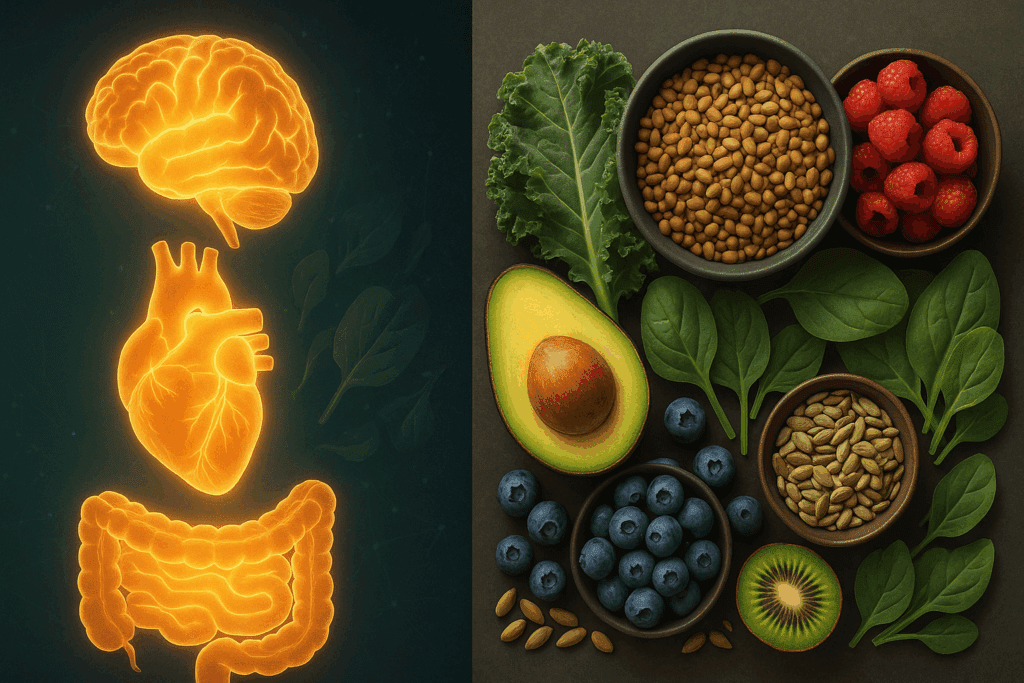
The Science-Backed Benefits of a Plant-Based Diet
The decision to follow a vegetarian diet is often motivated by health, and for good reason. Decades of research have shown that plant-based eating can reduce the risk of chronic diseases, particularly those related to cardiovascular health. The absence of saturated fats found in meat and the abundance of fiber, antioxidants, and phytochemicals in plant-based foods make vegetarian diets highly protective. When crafted mindfully, a vegetarian food list is naturally rich in nutrients that support the immune system, regulate inflammation, and promote metabolic balance.
Scientific studies published in journals such as The American Journal of Clinical Nutrition and The Lancet have linked vegetarian and vegan diets with lower incidences of hypertension, type 2 diabetes, and certain cancers. These outcomes are often attributed to the high intake of plant-derived nutrients, including vitamins C and E, folate, magnesium, and polyphenols. Additionally, plant-based diets tend to be lower in energy density, making them effective for weight control without the need for strict calorie counting.
Importantly, the health benefits of vegetarian diets extend beyond disease prevention. Evidence also points to improved digestive health due to higher fiber intake, better kidney function, and enhanced mood and mental well-being. By centering meals around whole, unprocessed foods, a vegetarian grocery shopping list can become a roadmap to vitality. However, it’s essential to note that these benefits are most pronounced when the diet is well-balanced. A diet heavy in refined carbohydrates or processed vegetarian foods may lack the nutrients needed to support optimal health. That’s why constructing a thoughtful vegetarian diet shopping list is crucial.
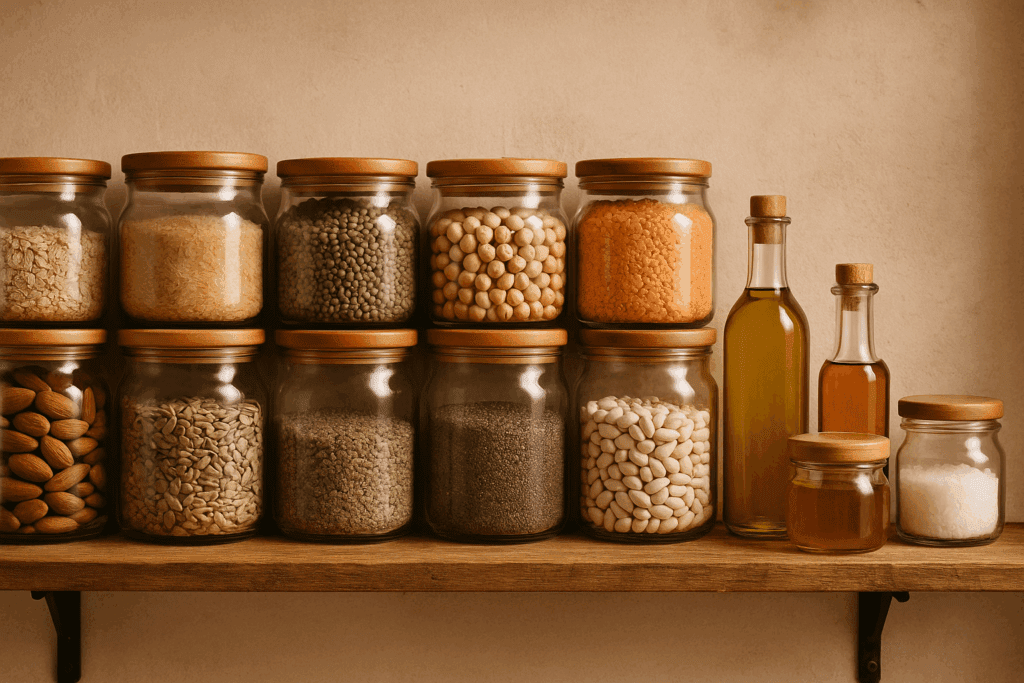
Building the Foundation: Staples for a Well-Rounded Vegetarian Pantry
A well-organized vegetarian pantry is the cornerstone of successful meal planning. Stocking up on essentials ensures that quick, nutritious meals are always within reach. Grains such as brown rice, quinoa, oats, and whole-wheat pasta form the backbone of many vegetarian dishes. These complex carbohydrates provide lasting energy, essential B vitamins, and dietary fiber, making them indispensable on any vegetarian diet grocery list.
Legumes are equally foundational. Lentils, chickpeas, black beans, and split peas offer plant-based protein, iron, and soluble fiber, supporting both satiety and gut health. Keeping a variety of canned or dried beans on hand allows for flexibility in meal preparation, whether you’re crafting soups, stews, curries, or grain bowls. Including legumes in your vegetarian food list ensures that protein needs are met without relying on heavily processed meat substitutes.
Nuts and seeds deserve a prominent place in every vegetarian shopping list. Almonds, walnuts, chia seeds, flaxseeds, and pumpkin seeds are nutrient-dense, providing healthy fats, protein, zinc, and omega-3 fatty acids. These ingredients not only enhance the flavor and texture of meals but also support heart and brain health. Nutritional yeast, a vegan-friendly source of vitamin B12, can be added to sauces, soups, or even popcorn for a cheesy flavor and nutritional boost.
Don’t overlook oils and condiments. Extra virgin olive oil, sesame oil, tamari, tahini, and apple cider vinegar offer depth and complexity to dishes while contributing beneficial antioxidants and essential fatty acids. These ingredients can elevate simple meals and add versatility to your cooking repertoire. Incorporating these items into your vegetarian diet shopping list helps transform basic ingredients into delicious, satisfying meals.
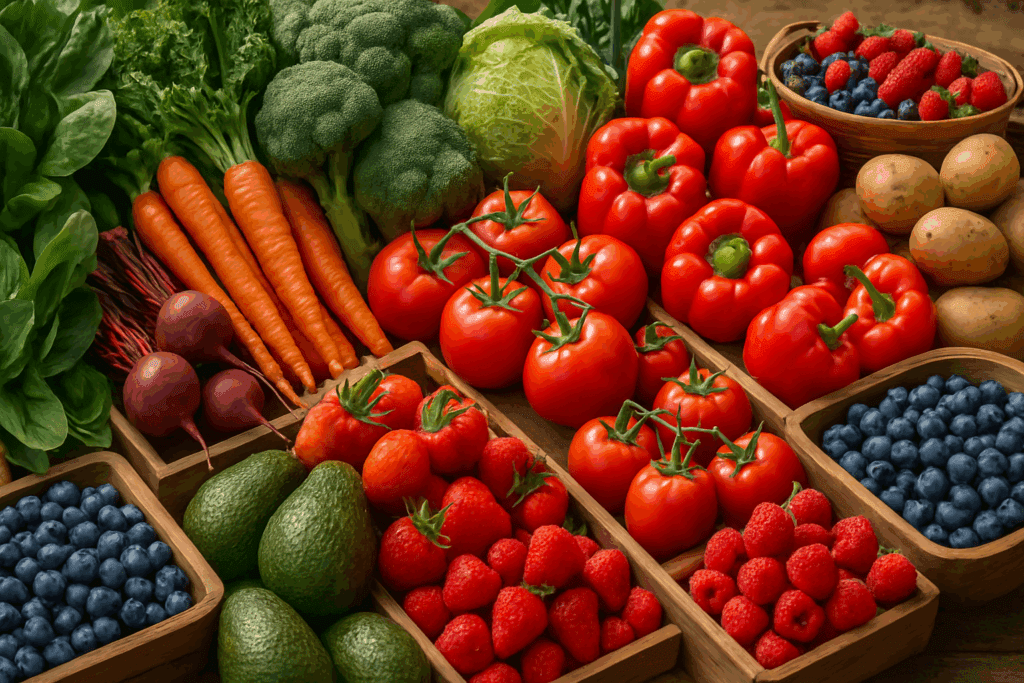
Fresh Produce: The Heart of a Veggie Shopping List
Vegetables and fruits are the most vibrant and nutrient-rich components of any vegetarian grocery shopping list. Eating a rainbow of produce ensures a wide intake of vitamins, minerals, and phytochemicals, each with unique health benefits. Leafy greens such as kale, spinach, Swiss chard, and arugula are powerhouses of iron, calcium, and vitamin K. These greens support bone health, blood clotting, and cellular repair, making them an essential daily inclusion.
Cruciferous vegetables—broccoli, cauliflower, Brussels sprouts, and cabbage—contain compounds like sulforaphane that have been studied for their cancer-preventive properties. Root vegetables such as sweet potatoes, carrots, and beets provide complex carbohydrates along with beta-carotene, potassium, and fiber. Including a diverse mix of these vegetables in your vegetarian food list not only boosts nutrition but also adds visual appeal and variety to meals.
Fruits, too, are an important part of a balanced vegetarian diet. Berries are especially rich in antioxidants like anthocyanins and vitamin C, while bananas, oranges, apples, and pears offer quick energy and essential nutrients such as potassium, soluble fiber, and natural sugars. When shopping, prioritize seasonal and locally grown produce for maximum flavor and sustainability. Organic options may reduce exposure to pesticides, though washing all produce thoroughly remains important.
Avocados, tomatoes, bell peppers, cucumbers, and zucchini round out the fresh produce section with a combination of hydration, healthy fats, and culinary versatility. Whether consumed raw, roasted, grilled, or sautéed, these items enhance both the nutrition and sensory experience of a meal. Including a generous selection of fresh produce in your vegetarian diet grocery list ensures that your meals remain vibrant, nutrient-dense, and deeply satisfying.
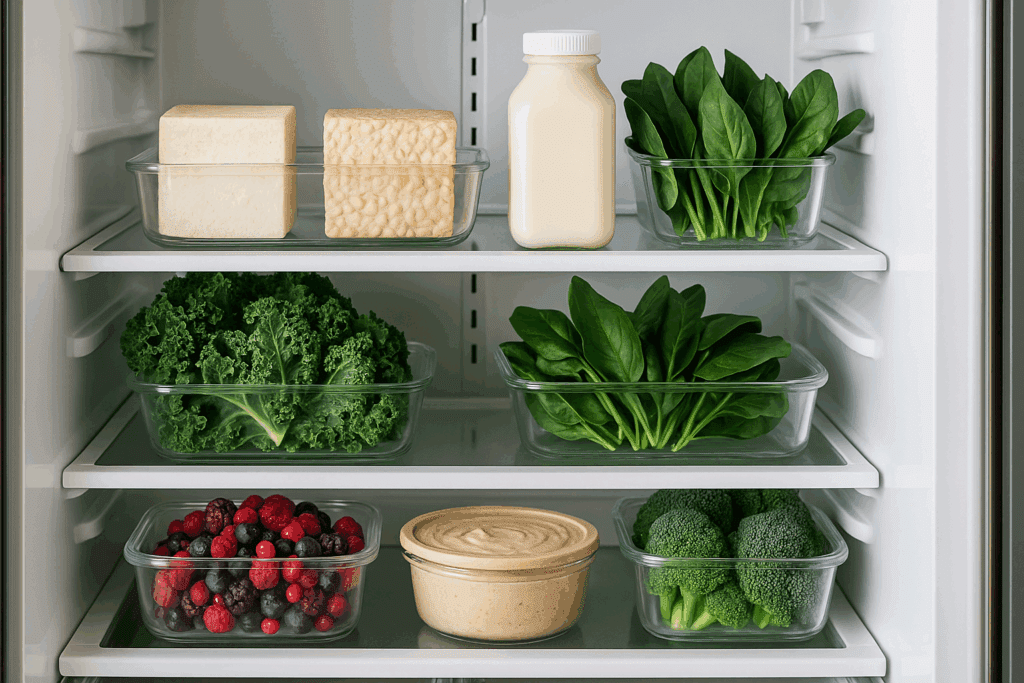
Smart Choices in the Refrigerated and Frozen Aisles
While fresh produce and pantry staples form the core of a vegetarian shopping list, refrigerated and frozen items offer convenience without compromising nutrition. In fact, frozen fruits and vegetables are often flash-frozen at peak ripeness, preserving their nutrient content and extending shelf life. Bags of frozen spinach, peas, berries, and mixed vegetables can be lifesavers on busy days, allowing you to assemble balanced meals in minutes.
The refrigerated section is where you’ll find plant-based dairy alternatives and protein-rich staples that round out the vegetarian food list. Unsweetened almond, soy, oat, and cashew milk can be used in cooking, baking, or simply as beverages. These options are often fortified with calcium, vitamin D, and vitamin B12—nutrients that are especially important for those on a plant-based diet. Be sure to check labels for added sugars and choose unsweetened varieties whenever possible.
Tofu and tempeh are excellent sources of complete protein, iron, and probiotics. These soy-based foods are incredibly versatile, absorbing the flavors of marinades and spices while providing texture and nutrition. When included regularly in a vegetarian diet shopping list, they help ensure adequate intake of essential amino acids. For those who prefer variety, seitan—a high-protein wheat-based meat substitute—offers a chewy texture and can be a welcome addition in moderation.
Don’t overlook items like hummus, guacamole, and fresh salsas, which add flavor and nutrition with minimal effort. These spreads can serve as dips, sandwich fillings, or salad toppings. Similarly, fermented foods like kimchi, sauerkraut, and kombucha contribute beneficial bacteria to support gut health. Including these in your vegetarian grocery shopping list introduces not only diversity but also functional benefits to your diet.
Label Literacy: Reading for Health and Quality
Navigating a grocery store as a vegetarian requires more than selecting plant-based items; it demands discernment in reading labels and understanding ingredients. Many processed foods—while technically vegetarian—contain hidden additives, preservatives, or excessive sodium that can undermine a healthy diet. By learning to interpret labels accurately, shoppers can avoid pitfalls and make informed choices aligned with their wellness goals.
Start by checking the ingredient list. Short, recognizable ingredients usually indicate less processing and higher nutritional quality. Be wary of added sugars, hydrogenated oils, artificial colors, and flavor enhancers like monosodium glutamate (MSG). Although some of these ingredients may be permissible in small amounts, they often signal lower-quality products that do not belong on a whole-food-focused vegetarian shopping list.
Nutrition labels also offer valuable insights into macronutrient balance and micronutrient content. Look for fiber-rich foods with at least three grams of fiber per serving, especially when choosing breads, cereals, and packaged snacks. For protein sources, aim for at least five to ten grams per serving, particularly if you’re relying on packaged items like veggie burgers or meat alternatives. Avoid excessive saturated fat and sodium, which can detract from the heart-health benefits of a vegetarian diet.
Additionally, pay attention to food certifications. Labels such as USDA Organic, Non-GMO Project Verified, and Fair Trade provide guidance on farming practices, ingredient sourcing, and environmental impact. While these designations are not essential for health, they can align with ethical and sustainability values that often accompany vegetarianism. Including certified products on your vegetarian food list can help you shop more mindfully and with greater purpose.
Mastering label literacy is a skill that improves with time and practice. As you become more familiar with trusted brands and ingredients, grocery shopping becomes faster, easier, and more aligned with your nutritional priorities. A thoughtful vegetarian grocery shopping list, therefore, reflects both what you buy and how you choose to buy it—a balance of health, ethics, and informed decision-making.
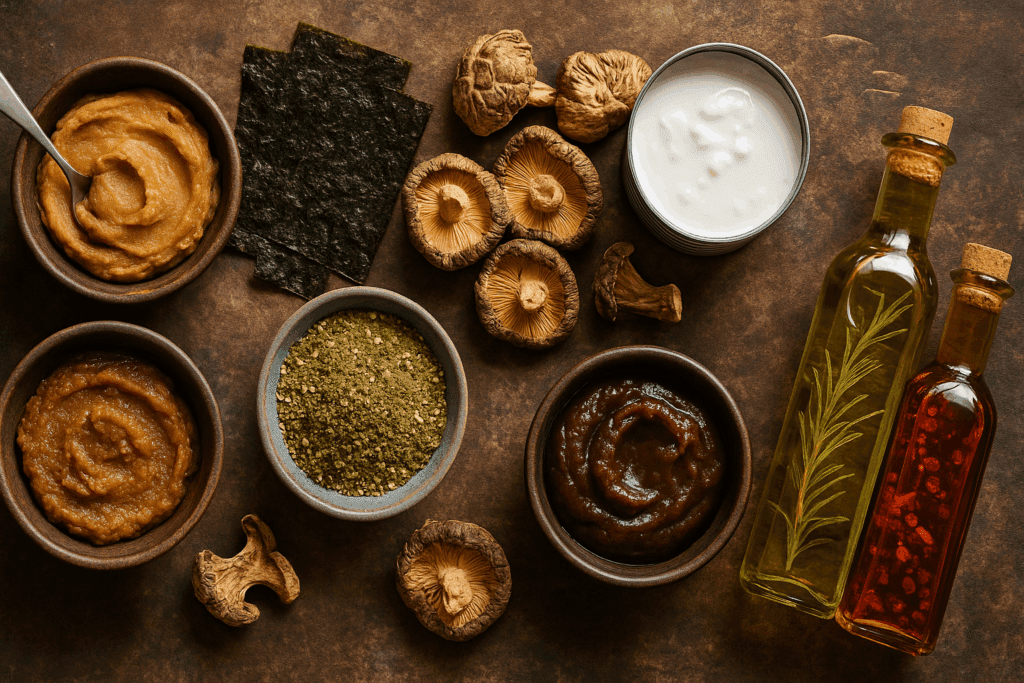
Beyond the Basics: Specialty Ingredients and Culinary Enhancements
For those ready to take their plant-based cooking to the next level, the vegetarian grocery shopping list can expand to include specialty ingredients that offer depth, variety, and global flair. These ingredients allow home cooks to reimagine familiar dishes with plant-based creativity, all while reinforcing nutritional balance. Items such as miso paste, coconut milk, harissa, and tamarind concentrate bring powerful flavor profiles that enrich soups, sauces, and stews. These staples of Asian, African, and Middle Eastern cuisine offer not only culinary diversity but also unique phytonutrients and anti-inflammatory compounds that contribute to overall wellness.
Dried mushrooms, such as shiitake or porcini, can serve as umami-rich additions to broths and stir-fries, while sea vegetables like nori, wakame, and dulse offer iodine and trace minerals often missing in land-based foods. Including these in a vegetarian food list helps address micronutrient gaps and introduces new textures and flavors. Nutritional diversity is essential in a vegetarian diet, and embracing these global pantry additions can help sustain long-term engagement with plant-based eating.
Flavored vinegars, specialty salts, and spice blends also have their place. A sprinkle of smoked paprika or za’atar can instantly transform roasted vegetables, while infused oils and exotic condiments can elevate the simplest of grain bowls. These ingredients support a more immersive and joyful cooking experience, turning what might seem like dietary restrictions into opportunities for exploration and delight. With a well-rounded vegetarian diet grocery list that includes these culinary enhancers, food becomes not only nourishment but also art.
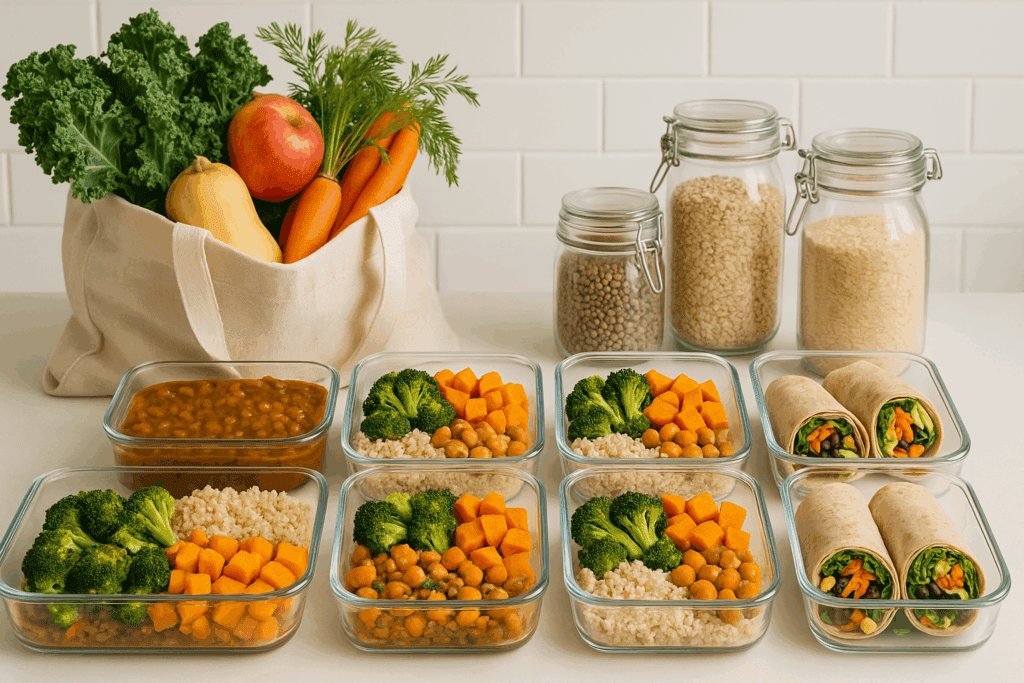
Planning Ahead: Tips for Effective Meal Prep and Budget-Friendly Shopping
Creating a successful vegetarian shopping list also means thinking strategically about how to use your purchases efficiently. Meal prep, when done thoughtfully, not only saves time but also ensures consistency in nutrient intake. Planning your meals for the week—whether through full-scale batch cooking or assembling key components in advance—can make it easier to stick to your vegetarian or vegan grocery list without resorting to processed or convenience foods.
Start by identifying a few staple meals you enjoy and can easily rotate. Build your shopping list around those meals, ensuring you have ingredients that overlap or can be repurposed. For example, a large batch of lentils can become part of a stew, a salad topping, or even a burger base. Roasted vegetables can serve as sides, wrap fillings, or grain bowl ingredients throughout the week. By shopping with meals in mind, you reduce waste and increase the likelihood of using what you buy.
For those shopping on a budget, bulk bins can be a treasure trove of affordable staples. Purchasing grains, beans, and spices in bulk not only saves money but also allows for flexible portioning. Frozen produce and generic store-brand plant milks are often just as nutritious as their premium counterparts and can significantly cut costs. Coupons, loyalty programs, and shopping apps also make it easier to stick to a vegetarian food list without overspending. Being strategic in both planning and purchasing allows you to maintain a vegetarian diet grocery list that supports both health and financial sustainability.
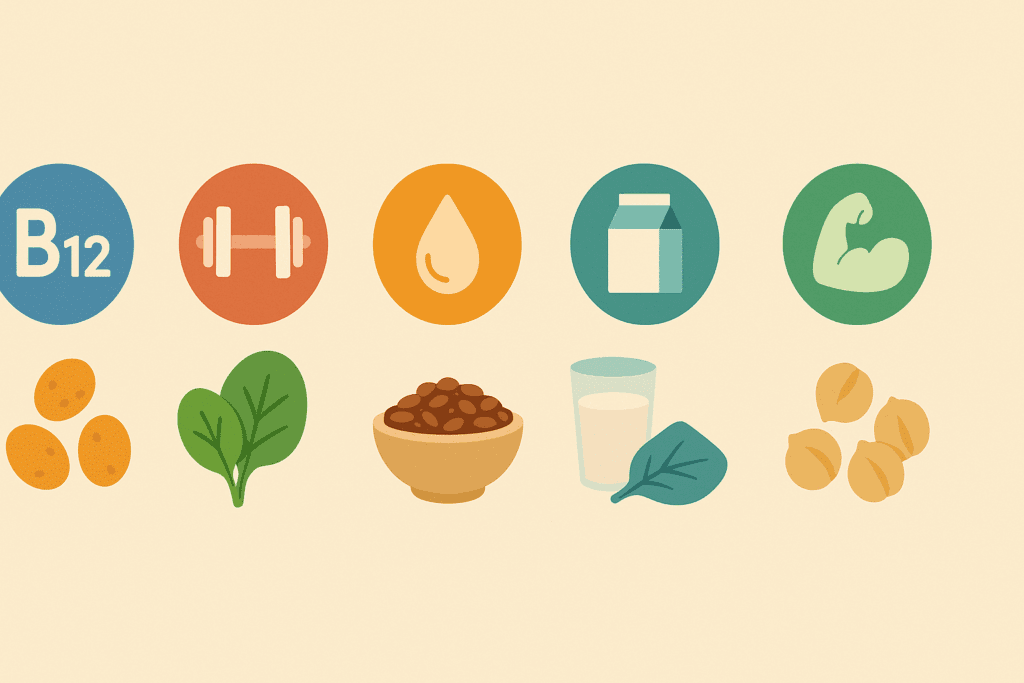
Supplementation and Nutrient Considerations for Plant-Based Eaters
While a well-planned vegetarian grocery shopping list can cover most nutritional needs, there are specific nutrients that require more careful attention in a plant-based diet. Vitamin B12, for instance, is not naturally found in plant foods and must be consumed through fortified products or supplements. Fortified cereals, plant milks, and nutritional yeast are common sources, but many registered dietitians recommend a reliable B12 supplement to ensure consistent intake.
Iron is another critical nutrient, especially for women of reproductive age. Plant-based iron—known as non-heme iron—is less bioavailable than the heme iron found in animal products, meaning it’s absorbed less efficiently. To compensate, pair iron-rich foods like lentils, tofu, and spinach with sources of vitamin C such as citrus fruits or bell peppers, which enhance absorption. Including these strategic pairings in your vegetarian diet shopping list can help maintain healthy iron levels and avoid deficiencies.
Calcium and omega-3 fatty acids also merit consideration. While calcium can be found in leafy greens, fortified plant milks, and tofu, omega-3s are abundant in flaxseeds, chia seeds, and walnuts. For those who don’t consume algae-based supplements, these foods should appear regularly in the vegetarian food list. By being proactive and informed, vegetarians can meet their nutritional needs while still enjoying a diverse and satisfying diet.
Protein, while often the center of concern, is relatively easy to obtain from a wide range of plant foods. Legumes, soy products, whole grains, nuts, and seeds provide ample protein when consumed in variety and sufficient quantity. The key is not to rely on any one food but to embrace diversity and balance. When your vegetarian grocery shopping list includes an array of complementary protein sources, it’s easy to meet daily requirements without compromising on taste or variety.
A Lifestyle, Not Just a List: Embracing the Plant-Based Mindset
One of the most powerful outcomes of maintaining a vegetarian or vegan grocery list is the shift in mindset that often follows. Grocery shopping becomes more intentional, focused not only on sustenance but also on ethics, environmental sustainability, and personal well-being. Choosing to prioritize plants over animal products inherently aligns with values of compassion, stewardship, and respect for life. These motivations strengthen over time, making plant-based eating not just a routine, but a philosophy.
This mindset extends to other areas of life as well. From supporting local farmers and minimizing packaging waste to advocating for animal welfare and food justice, vegetarians often find that their grocery list is only the beginning of a much broader lifestyle transformation. It becomes a reflection of their identity, their values, and their commitment to living well—for themselves, for others, and for the planet.
Social support and community engagement also play a role. Joining vegetarian forums, attending plant-based cooking classes, or simply sharing meals with like-minded friends can reinforce positive habits and reduce feelings of isolation. These interactions can offer new recipe ideas, shopping tips, and emotional encouragement. As the vegetarian movement continues to grow, so too does the support network available to those who choose this path. A thoughtful vegetarian food list, therefore, is more than a nutritional tool—it’s a gateway to a thriving, purpose-driven way of living.
Frequently Asked Questions: The Vegetarian Grocery Shopping Experience
1. How can I make a vegetarian shopping list more personalized to my unique nutritional needs?
To personalize a vegetarian shopping list, it’s crucial to evaluate your individual health goals, dietary restrictions, and daily routine. For example, if you’re managing iron deficiency or low energy levels, your vegetarian food list should emphasize iron-rich sources like lentils, fortified cereals, and vitamin C-rich produce to enhance absorption. Athletes or active individuals may benefit from including higher-protein options like tempeh, edamame, and hemp seeds in their vegetarian diet grocery list. Consulting with a registered dietitian can offer targeted advice and ensure nutrient gaps are identified early, especially for those with pre-existing health conditions. Over time, tracking how different plant-based foods impact your energy, digestion, and mental focus can help refine your list into a more functional, personalized tool.
2. What are some innovative tech tools that can streamline building a vegetarian grocery shopping list?
Modern tools can transform how you build and manage a vegetarian grocery shopping list. Apps like Mealime, Yummly, and Forks Over Knives allow users to generate grocery lists based on selected plant-based recipes, offering a seamless way to plan meals and reduce food waste. More advanced platforms even integrate with wearable health tech, like Fitbit or Apple Health, to suggest vegetarian food list items aligned with your wellness metrics. Some apps allow barcode scanning and ingredient tracking, which can flag non-vegetarian additives in packaged products. For anyone just starting out, especially those with a beginner vegetarian grocery list, these tools can serve as supportive digital coaches that simplify shopping and reinforce healthy habits.
3. What are common mistakes people make when following a vegetarian diet grocery list, and how can they be avoided?
One frequent mistake is over-reliance on processed vegetarian foods, which may lack essential nutrients despite being plant-based. Another is failing to include adequate protein or healthy fats, which can lead to fatigue or nutrient deficiencies over time. To avoid these issues, a well-rounded vegetarian grocery shopping list should incorporate diverse whole foods like legumes, whole grains, nuts, and seeds alongside fresh produce. Also, shoppers often forget to rotate items on their vegetarian diet shopping list, which can result in a monotonous diet and limit exposure to beneficial phytonutrients. Diversifying your veggie shopping list every few weeks not only keeps meals exciting but also enhances long-term nutritional balance.
4. How can someone on a tight budget maintain a nutrient-dense vegetarian food list?
Maintaining a cost-effective vegetarian food list is entirely achievable with some smart strategies. Bulk-buying pantry staples such as oats, brown rice, lentils, and beans significantly reduces per-serving costs. Frozen vegetables and store-brand plant milks are often less expensive but retain nutritional quality, making them excellent additions to a vegetarian grocery shopping list. Planning meals around seasonal produce and using weekly store promotions can help build a budget-friendly vegetarian diet grocery list. Community-supported agriculture (CSA) boxes and farmers markets are also valuable for sourcing fresh produce at lower prices. When budgeting, prioritize nutrient-dense foods and keep indulgences like specialty vegan snacks or meat substitutes to occasional use.
5. What psychological benefits can come from maintaining a consistent veggie shopping list?
A consistent veggie shopping list can contribute to improved mental clarity, mood regulation, and reduced decision fatigue. The process of curating and sticking to a vegetarian grocery shopping list reinforces positive behavioral patterns, which can build a stronger sense of self-efficacy around food choices. Knowing your fridge and pantry are stocked with nourishing, whole-food ingredients can foster a sense of security and well-being. Some individuals report reduced anxiety around food and improved body image as a result of intentional eating habits supported by a vegetarian diet shopping list. Over time, this consistency becomes a form of self-care that nurtures both psychological resilience and physical health.
6. How can I adapt a vegetarian food list when traveling or living abroad?
Adapting your vegetarian food list while traveling involves flexibility and cultural curiosity. Research local cuisines beforehand to identify plant-based staples—such as lentils in India, tofu in Southeast Asia, or beans and corn in Latin America—and incorporate them into your vegetarian diet grocery list abroad. Consider packing shelf-stable essentials like chia seeds, protein powder, or nutritional yeast, which can enhance meals on the go. Many international grocery apps now allow you to browse and plan a vegan grocery list based on regional availability, making it easier to shop smart in unfamiliar environments. Embracing new ingredients and cooking methods can add global diversity to your veggie shopping list while maintaining nutritional adequacy.
7. What are some signs that my vegetarian grocery shopping list needs an update?
Stagnation in energy levels, recurring cravings, or digestive discomfort may signal that your vegetarian grocery shopping list is due for a refresh. As your body and lifestyle evolve—due to age, activity level, or health conditions—so should your vegetarian diet grocery list. If you notice you’re eating the same meals repeatedly or feel uninspired in the kitchen, it’s likely time to diversify your vegetarian food list. Regularly revisiting your goals, experimenting with new plant-based ingredients, and incorporating feedback from your body can guide necessary updates. A proactive approach keeps your grocery planning dynamic and aligned with your evolving health journey.
8. How do environmental and ethical values influence the construction of a vegetarian diet shopping list?
A vegetarian diet shopping list is often a reflection of deeper values around sustainability, animal welfare, and ecological impact. Opting for locally grown, organic produce reduces carbon emissions and supports regenerative farming practices. Including fair-trade certified items on your vegetarian grocery shopping list—such as coffee, chocolate, and bananas—reinforces ethical labor standards in global supply chains. For environmentally conscious shoppers, minimizing single-use packaging and prioritizing bulk purchases adds another dimension to the veggie shopping list. These choices align daily consumption habits with long-term planetary stewardship, creating a ripple effect of positive change beyond personal health.
9. How can families or households with mixed dietary preferences create a flexible vegetarian shopping list?
Creating a shared vegetarian shopping list in a mixed-diet household involves balance, communication, and compromise. Start with universally accepted staples like grains, vegetables, legumes, and dairy or plant-based alternatives that everyone can enjoy. From there, allow flexibility by including modular ingredients—like sauces, proteins, or toppings—that individuals can personalize based on their dietary preferences. This modular approach helps accommodate a vegetarian food list without alienating non-vegetarian family members. Over time, shared meals can evolve to feature more plant-based components, gradually nudging the household toward a predominantly vegetarian or vegan grocery list.
10. What future trends could shape how we use a vegetarian diet grocery list?
Emerging technologies, environmental shifts, and evolving consumer habits are all poised to influence the future of the vegetarian diet grocery list. Innovations like AI-powered grocery assistants, carbon footprint trackers, and precision nutrition apps will provide more data-driven, personalized shopping experiences. We’re also seeing a rise in regenerative agriculture products and lab-grown plant proteins that may soon become staples on the average vegetarian food list. As climate change reshapes agricultural availability, adaptability will become a vital skill for building a resilient veggie shopping list. Meanwhile, societal movements toward food justice and plant-forward public policies may lead to broader access and affordability for all, fundamentally transforming the landscape of vegetarian grocery shopping.
Conclusion: Your Vegetarian Grocery Shopping List as a Blueprint for Lifelong Health
Crafting and following a vegetarian grocery shopping list is not just a logistical exercise—it’s an act of empowerment. It allows individuals to take control of their health through intentional, evidence-based food choices rooted in scientific understanding and ethical awareness. When you consistently build your vegetarian food list with whole, nutrient-rich, plant-based options, you set the stage for improved energy levels, disease prevention, and a sustainable relationship with food.
A complete vegetarian diet shopping list considers every aspect of well-being—from nutrient density and culinary enjoyment to affordability and convenience. It honors the need for balance by including fresh produce, whole grains, legumes, plant-based proteins, healthy fats, and a range of flavor-enhancing ingredients. It respects individuality by accommodating preferences, cultural traditions, and dietary restrictions. And above all, it demonstrates trust in the power of plants to nourish, heal, and inspire.
As you continue to refine your own veggie shopping list, remember that perfection is not the goal—progress is. Each thoughtful purchase represents a step toward greater vitality, ethical alignment, and planetary stewardship. By embracing this process with curiosity and intention, your vegetarian grocery shopping list becomes more than a list—it becomes a blueprint for lifelong health, backed not only by nutrition science but also by lived experience, expertise, and compassion.

